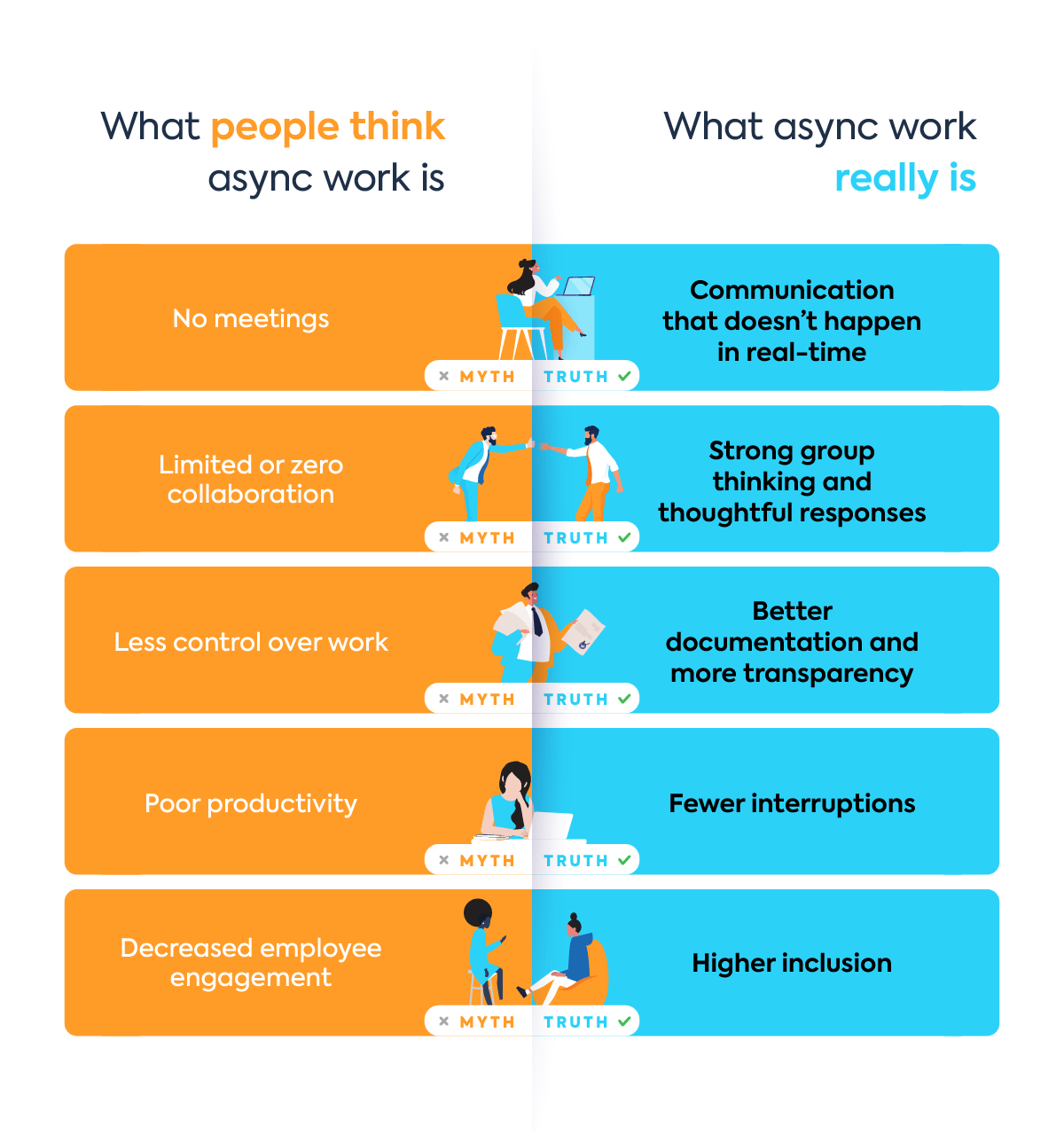Leslie is excited to start her new remote job. She specifically looked for a remote opportunity so she could have work flexibility—she wants to start her days early, take a long lunch to pick her daughter up from school, and finish work in the late afternoon.
But three weeks in, she’s struggling with her decision. She’s expected to be “always on” to support and meet with coworkers in different time zones. She barely has time to pick up her daughter, let alone spend any quality time. And she’s working longer hours than ever. Now what?
Leslie realizes what she wanted was not remote work, but async work.
The two may sound similar. But, as Leslie discovered, simply taking a team remote doesn’t guarantee flexibility or work/life balance. Working asynchronously is often a better bet for companies looking to support employees working on different schedules.
So how exactly does asynchronous work differ from remote work? And how do you make sure you are doing one and not the other?
What async work looks like
Async work doesn’t just mean working in different locations. It also means getting work done on different timelines without real-time interactions.
Many people have misconceptions about async work. It’s just business as usual but without all the meetings, right?
Not quite.
Let’s take a look at some of the myths of async work to understand what it is—and what it isn’t.

Myth: Asynchronous work means chatting on Slack vs. in a live meeting.
Fact: Async means communication doesn’t happen in real-time. Even when a company uses messaging apps, they’re not working asynchronously if there’s a general expectation for immediate response. Working asynchronously means sharing information and having a time lag between responses.
Myth: Async work kills collaboration.
Fact: A pause between responses can support strong group thinking. Employees still trade ideas and brainstorm solutions. Just not in real-time. The delay between contributions also gives people more time to process information than when decisions are expected quickly, leading to more thoughtful responses and may lead to more efficient solutions.
Myth: Async work gives you less control over work.
Fact: Documentation creates more transparency. Decisions and ideas that used to be discussed in meetings are now written down for easy reference and reminders. Better documentation lets you see exactly what’s going on with any project. It also helps with better decision-making and faster onboarding.
Myth: Async lowers productivity.
Fact: People are more productive without interruptions. Context switching interrupts effective work and leaves employees feeling stressed and overwhelmed. When people don’t feel pressured to break up their day checking and responding to messages, they’re able to stay focused for longer blocks of time.
Myth: Employees are less engaged when they’re working asynchronously.
Fact: Async work can lead to more inclusion. People don’t always speak up in a group setting–even in virtual meetings. Often the loudest voice is the one that gets the attention. Communicating offline levels the playing field so everyone has a chance to be heard.
Asynchronous work offers plenty of benefits. But there are also obstacles you need to be aware of if you want to make it work in your organization.
Looking for an eLearning platform to facilitate async work?
Build virtual and self-paced training sessions in TalentLMS.
The training platform that users consistently rank #1.
Potential obstacles for asynchronous employees
Moving directly from traditional or even remote work to async work without adjusting policies or preparing employees can cause problems. For instance, an async employee may run into the following:
- Blurred lines between work and personal life: When managers aren’t entirely on board with async communication, there can be pressure to respond immediately. Employees in different time zones end up working in their off hours just to keep up.
- Lack of trust: People working on different schedules have a more challenging time building strong team relationships. Without opportunities for real-time collaboration and casual conversations, employees may not build up the trust they need to hand off tasks and projects with confidence.
- Miscommunication: It can be easy to misconstrue meaning in the one-way communication that happens with async work.
- Weak company culture: Working completely asynchronously can leave employees feeling disconnected from their coworkers and the company.
If you want to succeed with an async work model, you need to have a plan in place to overcome these challenges before you get started.

5 tips for going async
Changing the way employees work means breaking old habits. And that takes time and training. Here are five tips to help you avoid the pitfalls mentioned above as you move your team to asynchronous work.
1. Start slowly
This is where the “it takes time” aspect of switching work styles comes in. Instant changes can leave people disoriented and make it much more likely tasks will fall through the cracks. Help people gain confidence in asynchronous work by implementing it a little at a time.
For example, start with “no meeting Wednesdays” to get employees used to having big blocks of time to work and waiting for responses to questions.
Think about introducing new tools for communication one at a time (e.g., get people up to speed using Slack before you get people using video messaging tools like Loom). This lets people slowly sort out which kind of communication is best for which types of information.
2. Develop clear help resources
Eliminate feelings of isolation and frustration by ensuring any async employee knows where to turn when they need help.
For instance, create documentation and FAQs people can access when they have questions about how to complete a task.
For more complex concerns, give them direction on who to reach out to (along with contact info) for technical support, HR issues, or subject matter expertise.
3. Establish clear policies and workflows
Reduce uncertainty and burnout by establishing up front what’s expected of people in the new work model. Clarify things like what hours people are expected to be available, how quickly they should respond to certain kinds of communication, and what platforms to use for each.
Set crystal clear expectations for how projects move through your production process and how tasks are handed off.
For instance, if you use project management software, set it up to inform people of each task and deadline assigned to them. Clarify how employees should resolve their tasks and who they need to notify to move it to next steps.
4. Offer communication training
Prevent communication roadblocks by teaching people the ins and out of effective asynchronous communication. This can mean training them on the technical aspects of how to use your various communications tools.
It can also mean getting them up to speed on the soft skills they need to get meaning across effectively. This might include courses on things like general communication, email and virtual communication etiquette, and effective listening.
Use your LMS to make training accessible to all your employees, regardless of where (or when) they go through it.
5. Give people the skills to maintain work/life balance
Async employees need strong discipline and organizational skills. Help prevent stress by training them in the skills for managing their workload. This can include work-related skills like time management and productivity.
It can also be helpful to teach people how to protect their own well-being. Consider including courses on topics like mindfulness and work/life balance to keep employees from getting burned out.
Meet TalentLibrary™
A growing collection of ready-made courses that cover the soft skills
your teams need for success at work![]()

Making async (or any work model) work for you
Just like remote or in-office work, async work may not be the right fit for everyone. Imagine Leslie from our opening example moving on to a fully remote company where everyone works asynchronously.
She can find the flexibility she was hoping for, but also might realize she misses the daily interactions and in-the-moment brainstorming she had with an in-office job.
In the same way, not every work arrangement will work for every company. But whether you opt for a hybrid, remote, or asynchronous work model, you can set your employees up for success by considering the potential downfalls and by making plans that will help you avoid them.
| Tags: asynchronous work,Employee Incentives,learning and development,Remote Employees,Remote Training


![Giving Remote Work Feedback To Employees [Tips and Tools]](https://images.www.talentlms.com/blog/wp-content/uploads/2022/11/remote-work-feedback-employees.png)
